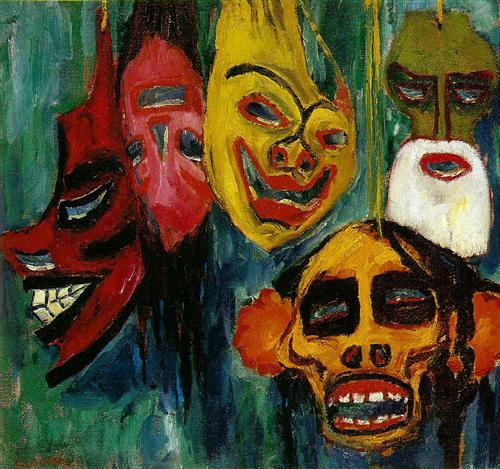Artist:
Title: Maskenstilleben3 / Masks Still Life
III
Year: 1911
Medium: Oil on canvas
Dimensions: 74 x 78 cm
“Masks Still Life III” (originally named “Maskenstilleben3”)
is the still life painting by Emil Nolde. There are 4 “Maskenstilleben” paintings
in total which were painted in the period of which Nolde was visiting different
places and museums (especially in Berlin museum fur Volkerkunde) to do his
preparatory studies for his so-called ethnographic still lifes that he made a
lots of sketches. “Masks Still Life III” is the one of them and is found to
represent the masks that exist in different sections of Volkerkunde museum, and
even some of which is believed from his own imagination.
“Masks Still Life III” is an expressionist
painting, not only because the painting was finished close to the period when
Nolde was a member of the Bridge (Die Brucke) that he was influenced by the
members there to have more stylish paintings, but the colours the painting has adopted
are emotively powerful and the distortions in the painting can easily be
observed. In addition, the painting is a primitive art.
As we can observe from the painting, the different
bold colours are used to explicitly give subjective feelings. The red masks on
the left top, for example, can give the feeling of anger and aggression. The
yellow and orange colour used for the masks at the central can give the feeling
of happiness and jealousy. The green colour used on the right top mask may be symbolized
as sickness to represent pain. The green mask with the red outlining the features
also suggests the painting is expressionist. The background colours are mainly
in blue and green to give a somber mood as well. The thickly applied paint and
obvious vertical brushstrokes in the painting also help the heavy emotion
intensity which makes the painting full of tension. These all put together are exhausting
and have great psychological effects.
The objects in the painting are distorted
as well. The shapes of the masks are angular which has suggested some subjective
feelings. The red mass on the top left for example are distorted vertically and
give a feeling of scares and fears. While there is one at the lower right is
pull horizontally, it gives a feeling of sympathy. On the bottom right mask,
there are the black marks to make it like a real skull. The yellow mask at the
central would look like sharing at somewhere as well and hiding back to the
background which looks like to despise.
The composition of the painting appears not
having balance or harmony. This helps to be consistent with the somber tone.
There are three focuses on the painting that 3 masks hanged on the left and the
one in the front and the one at the black. They are grouped with the different emotion
expressed
The painting is categorized as a primitive art as well. Emil Nolde built up specific concern over the non-western arts and their displays in museums as well. It is more than easy to observe from the style of the painting Nolde had that his
objects in the painting are flattened. This illustrates the influences of the African arts on him like many other artists like Picasso. The influence on Emil Nolde is also because he was interested in Picasso's painting as well.
The origins of the masks are from different artifacts as well. There is the obvious one at the right top that is from Africa and the far left red mask is actually from Oceanic Island. Some may even argue that the painting is also a response to the alienating and reified conditions of early twenthieth-century society in Europe as well because of its emotional intensity.
The origins of the masks are from different artifacts as well. There is the obvious one at the right top that is from Africa and the far left red mask is actually from Oceanic Island. Some may even argue that the painting is also a response to the alienating and reified conditions of early twenthieth-century society in Europe as well because of its emotional intensity.
Provoking Questions:
Should the painting with the context from
imagination or the distorted context primarily from the still life objects be categorized
as still life anymore?
Would you think there would be no concern
to the society underlined in “Masks Still Life III”? Why?
Resources:
Emil Nolde's Drawings from the Museum für
Völkerkunde, Berlin, and the 'Maskenstilleben1-4', 1911 by Jill Lloyd
Quote:
“There is silver blue, sky blue and thunder
blue. Every colour holds within it a soul, which makes me happy or repels me,
and which acts as a stimulus. To a person who has no art in him, colours are
colours, tones tones and that is all. All their consequences for the human
spirit, which range between heaven to the hell, just go unnoticed.” Written by Nolde,
1942.
“Everything that passed before one’s eyes
awakens the whole gamut that lies between joy and suffering, happiness and
unhappiness” written by Nolde.

Carol Lau:
ReplyDelete1) Good and clear analysis on color, shapes, composition and sufficient examples are given.
2) Ideas are well organized. However, there is no brief conclusion. References are also not enough. It will be good to include more quotes of scholars ' opinions to support the analysis part.
This comment has been removed by the author.
ReplyDeleteCarol Lau:
ReplyDeleteThe quotations should be inserted into the essay instead of at the end.